|
Thread Number: 50753
/ Tag: Vintage Automatic Washers
MAYTAG TWO-BELT TRANSMISSION QUESTION |
[Down to Last] |

|
| Post# 730277 , Reply# 1 1/24/2014 at 20:23 (3,742 days old) by beekeyknee (Columbia, MO) | ||
 | ||
| Post# 730722 , Reply# 10 1/26/2014 at 16:17 (3,740 days old) by jwpate () | ||
|
Whatever is to be done, the first step must be to clean it back till reaching good sound metal. And, this step takes me past all the aforementioned ideas. It will have to be a butt welded patch of steel. 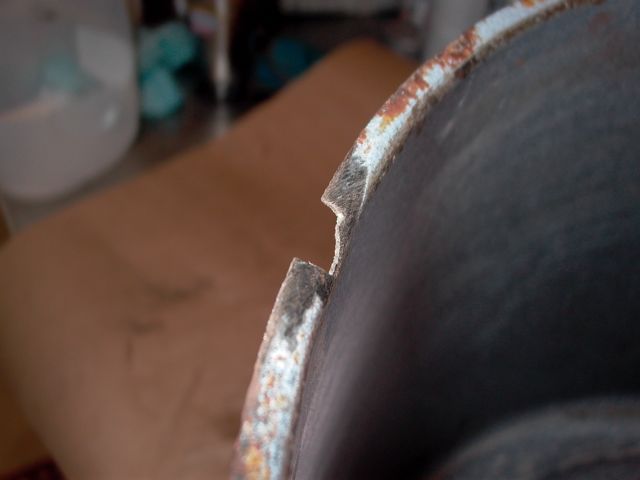
| ||
| Post# 730723 , Reply# 11 1/26/2014 at 16:20 (3,740 days old) by jwpate () | ||
|
So, start by hammering out a patch to the contours needed, place it in position and scribe the edge pattern onto the tub, then cut out to match. 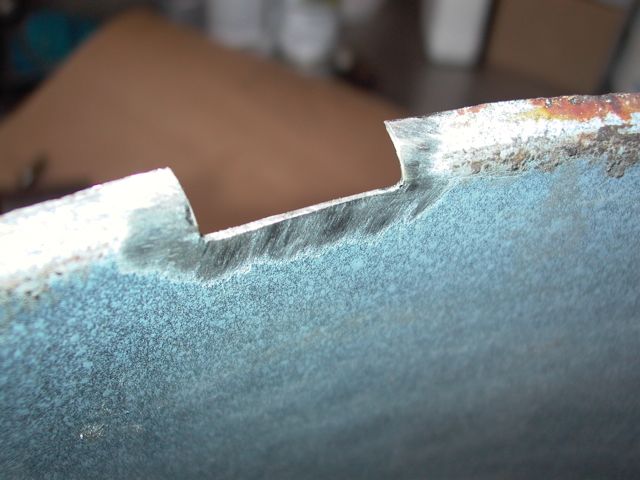
| ||
| Post# 730725 , Reply# 12 1/26/2014 at 16:22 (3,740 days old) by jwpate () | ||
|
Weld it in - grind it smooth- and move on to the next issue. 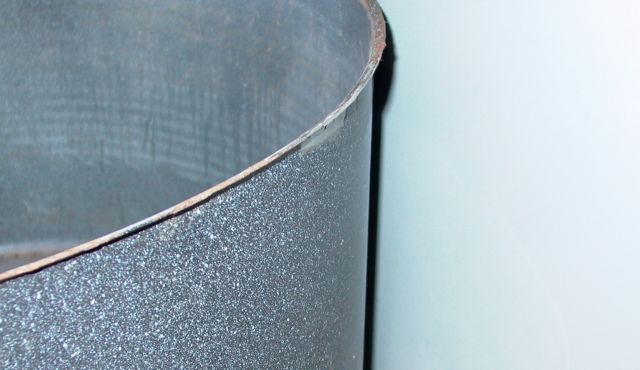
| ||
| Post# 730726 , Reply# 13 1/26/2014 at 16:27 (3,740 days old) by jwpate () | ||
|
And this will do. Here is the drain pipe of the outer tub, looking worse for wear. There seems enough length remaining for attaching a hose, but how sound is this pipe??? 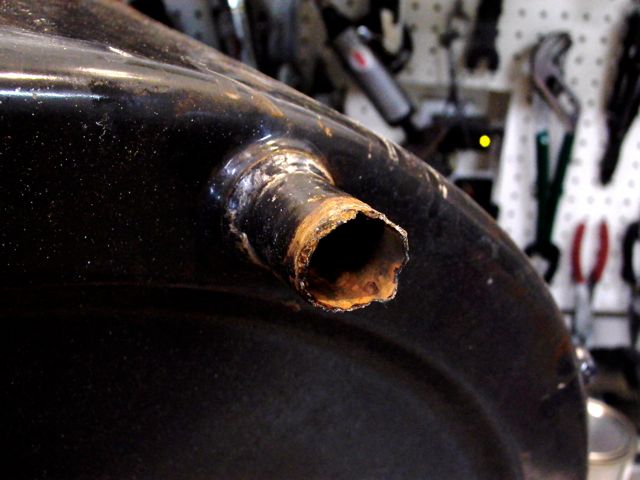
| ||
| Post# 730744 , Reply# 16 1/26/2014 at 17:36 (3,740 days old) by washman (o) | ||
|
Good work Your work with metal is most impressive. | ||
| Post# 730800 , Reply# 17 1/26/2014 at 21:06 (3,740 days old) by DigAPony () | ||
|
The tub is porcelain enamel finish. I'd suggest using POR-15 on the rough spots and use as is. If you decide to strip it and re-coat there are places that can do a porcelain enamel finish for not much more that powder coating. | ||
| Post# 731610 , Reply# 19 1/29/2014 at 18:07 (3,737 days old) by jwpate () | ||
|
And while taking the top cover apart, I came upon this bonus. There can be seen a wiring diagram for my model, where it has been taped in for all these years. 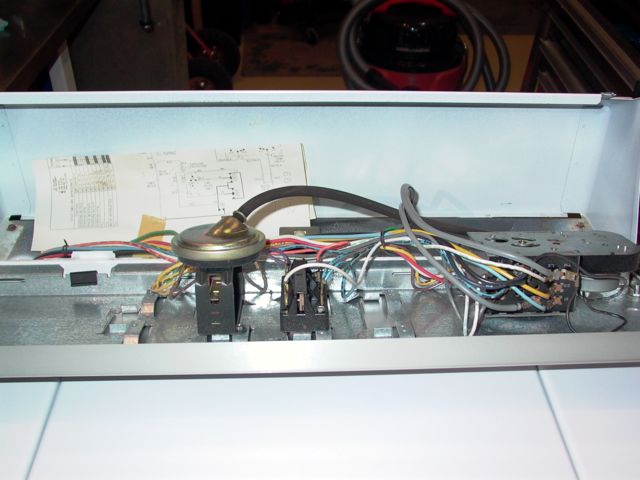
| ||
| Post# 731613 , Reply# 21 1/29/2014 at 18:20 (3,737 days old) by jwpate () | ||
|
Took the inlet valve apart to gain a better understand of how it works. It is those rubber discs which eventually will perish enough to allow water leaks, and I expect serious ones. 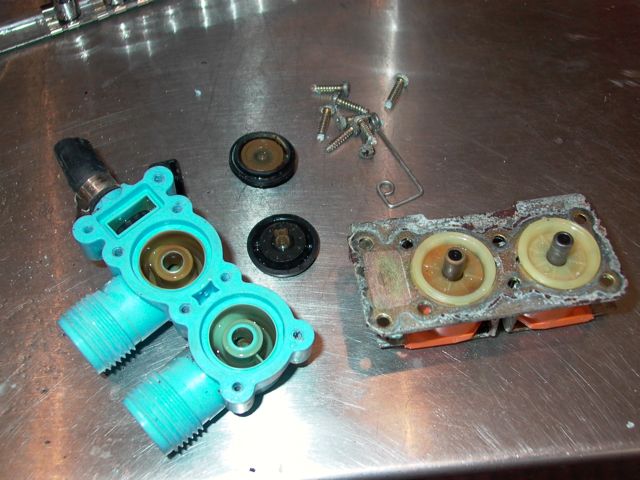
| ||
| Post# 731622 , Reply# 24 1/29/2014 at 19:04 (3,737 days old) by jwpate () | ||
|
And the mail has just been brought in. With is is this like new factory workshop manual for the exact model I am working on. Mine is a 112. This is great news, and was on eBay last week. 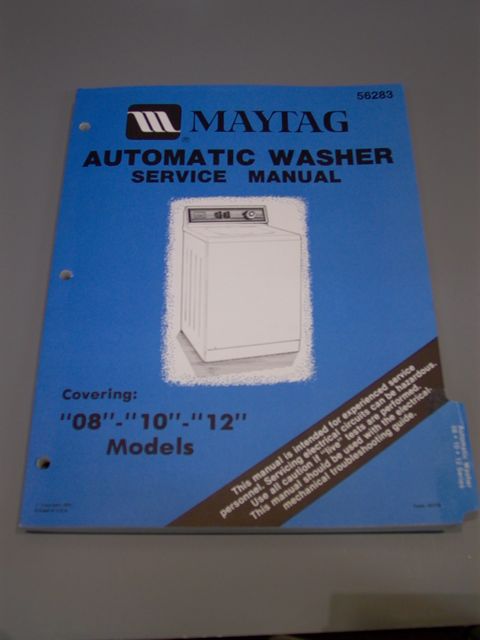
| ||
| Post# 731636 , Reply# 25 1/29/2014 at 19:52 (3,737 days old) by beekeyknee (Columbia, MO) | ||
 | ||
| Post# 731661 , Reply# 27 1/29/2014 at 21:56 (3,737 days old) by DigAPony () | ||
|
bolts you may reuse them again. I'd put some RTV sealant on the bolt gaskets for a little extra insurance. | ||
| Post# 731809 , Reply# 28 1/30/2014 at 14:32 (3,736 days old) by redcarpetdrew (Fairfield, CA) | ||
Wow.
I've been following this thread with great interest and all I can say is WOW! You are doing one heck of a job restoring this little one. I admit I came in on this later than most. I work at a Maytag service center in Reno. I do have access to a ton of service manuals and part break downs. What do you need, if anything? Might I ask what part of Nevada are you in? It's really good to know I'm not the only AW'er here now!
If this helps, this is a thread I did a while back with part numbers, etc... Hope to hear from you! RCD CLICK HERE TO GO TO redcarpetdrew's LINK | ||
| Post# 731829 , Reply# 30 1/30/2014 at 15:52 (3,736 days old) by redcarpetdrew (Fairfield, CA) | ||

For a first attempt, you are out shining some techs I've known. The only thing I'm not certain about is replacing the lower o ring seal on the lower transmission shaft. I've not seen anyone use the newer lip seal in place of the o ring as I thought the lower shafts were slightly different between the o ring using helical and the lip seal using orbital. I by no means claim to be the authority, since when I do it ends up spanking me, and will love to see the results of experimentation.
That is the best example of saving a rusted outer tub ever! You, my friend, have the touch. Keep going! RCD | ||
| Post# 731841 , Reply# 34 1/30/2014 at 17:45 (3,736 days old) by redcarpetdrew (Fairfield, CA) | ||
There we go.
As I said, not the all seeing!
Forgot that during a short period when they were phasing the orbital in, both styles got the lip seal. Good show! Done that lip seal surgery a few times. Not bad to do but sometimes is annoying as it doesn't last (very seldom, tho...) I am just loving the picture I have in my head of what she's going to look like when you're done! Can't wait for the inaugural wash (with accompanying hi def video of course!). Almost worth the roadie to Vegas to watch her rebirth. RCD | ||
Post# 731871 , Reply# 35 1/30/2014 at 19:38 (3,736 days old) by combo52  (50 Year Repair Tech Beltsville,Md) (50 Year Repair Tech Beltsville,Md) |
||
Cool Rebuilding Job
I know you are having fun with it. A Few Thoughts that might help.
Powder coating the outer-tub should be very sufficient, I have never found a company that will actually re-coat porcelain on metal as thin as an outer tub. Most companies want to sandblast off the old coating first and doing so on thin metal can literally leave holes. As a technician for over 40 years I have never seen a nylon pinion gear or the thrust washers wear to the point that they caused any problem with the operation of the washer, and I suspect that if you wanted to disassemble your rebuilt MT transmission after about two years of use you will see the same scoring and very slight wear on the nylon pinion gear that the transmission you are rebuilding now shows. The brake lining of the brake assembly looks completely normal as it is for all practical purposes as good as new. The orignal MT center pull hose clamps are a very good type of clamp, and you are correct that the typical worm gear clamps are not a great hose clamp, overall the best type of clamp you can have are the flat spring clamps, but unfortunately you must have the exact size for the job, so the SS band clamps you are using are as good as the orignal MT clamps and should work great for this purpose. John L. | ||
Post# 731944 , Reply# 37 1/31/2014 at 03:46 (3,736 days old) by jetcone  (Schenectady-Home of Calrods,Monitor Tops,Toroid Transformers) (Schenectady-Home of Calrods,Monitor Tops,Toroid Transformers) |
||
A very impressive | ||
| Post# 732009 , Reply# 39 1/31/2014 at 11:10 (3,736 days old) by beekeyknee (Columbia, MO) | ||

James,
Softened water and water heaters don't mix well. I found out the hard way. Here's what I did. Read the link in the link first. It was quite an ordeal, but all seems well now. Brian CLICK HERE TO GO TO beekeyknee's LINK | ||
| Post# 732065 , Reply# 44 1/31/2014 at 16:00 (3,735 days old) by JWPATE () | ||
|
Naturally, I waited until the top was on the cabinet before fitting the drain stem and anti-syphon valve. That way it was as awkward as I could make it. 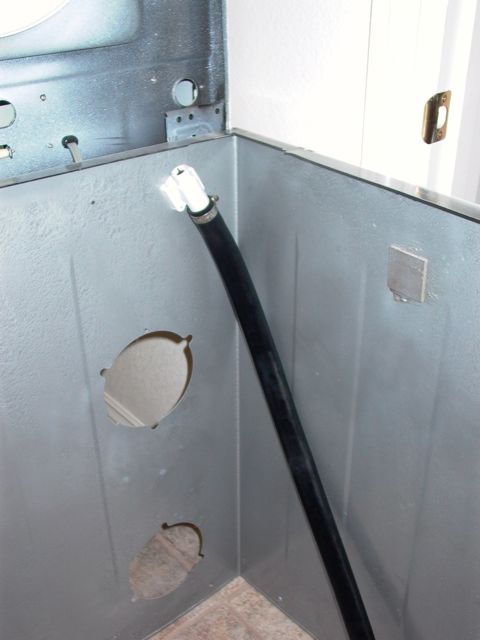
| ||
Post# 732131 , Reply# 45 1/31/2014 at 20:19 (3,735 days old) by combo52  (50 Year Repair Tech Beltsville,Md) (50 Year Repair Tech Beltsville,Md) |
||
Anti-Siphon Device in The Drain Line
This was not required by the Feds or even plumbing codes, but rather allowed the washer to be used with a floor drain, It also eliminated many other service calls such as an overflowing washer when the end of the drain hose becomes submersed in a sink that is backing up and the washer starts agitating for rinse and sucks all the backed up water in sink back into the washer and causes the washer to overflow. This type of event often cost the appliance maker money on warranty calls. MT did eliminate this feature later on.
| ||
| Post# 732146 , Reply# 46 1/31/2014 at 21:36 (3,735 days old) by JWPATE () | ||
|
That is very interesting to learn the true reasons for that anti-syphon device. It is simple enough that probably it didn't often become the source itself of leaks. | ||
| Post# 732215 , Reply# 47 2/1/2014 at 10:25 (3,735 days old) by beekeyknee (Columbia, MO) | ||

It looks like you have a late model Mallory timer in that machine. I usually see Kingston timers in that age of machine, but it can vary. The timer can be cleaned and lubricated if you want. With neoprene gloves on, I submerge the timer in kerosene and operate it while submerged. Then I let it dry overnight in a ventilated area and after it's dry I spray the timer down with Tri-flow spray or silicone spray, shake out the excess and let set for awhile. The escapement on your timer is very simple compared to the early model ones.
You might want to wait until you get the rest of your rebuild done before messing with the timer, if you choose to at all. That timer can be pulled out of there any time to be worked on. And don't forget to remove the motor before maintenance. CLICK HERE TO GO TO beekeyknee's LINK | ||
| Post# 732233 , Reply# 48 2/1/2014 at 13:22 (3,734 days old) by JWPATE () | ||
|
Yes, that is quite interesting, and I just may have a go at that timer in the next few days. Otherwise running out of things to do while waiting for the tub. For this morning, I turned my attention to the main washer motor and its spring plates. 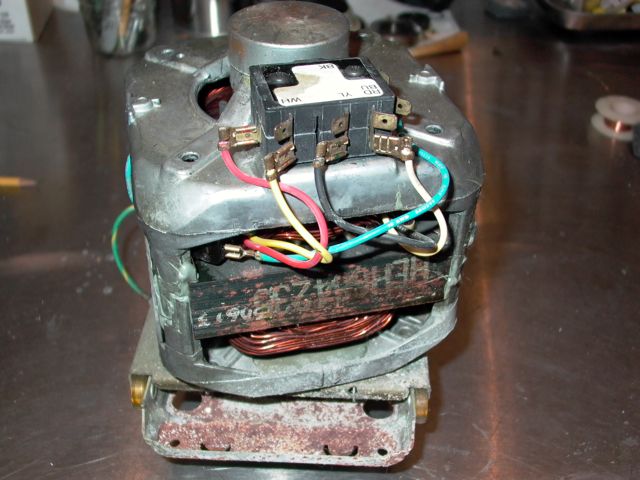
| ||
| Post# 732234 , Reply# 49 2/1/2014 at 13:25 (3,734 days old) by JWPATE () | ||
|
Not a pretty sight is it, and the underside looks even worse. Still I was wondering about reusing those plates, after cleaning them up and re-plating in zinc. 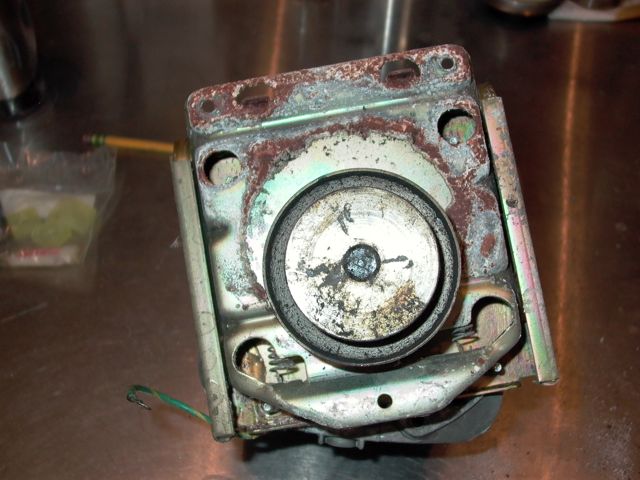
| ||
| Post# 732245 , Reply# 54 2/1/2014 at 14:01 (3,734 days old) by JWPATE () | ||
|
I did conduct a crude testing of the springs, and found that a one-inch extension required just about two pounds in both the old and the new. The new required just slightly more poundage I thought, but likely to have been within the margin of error. 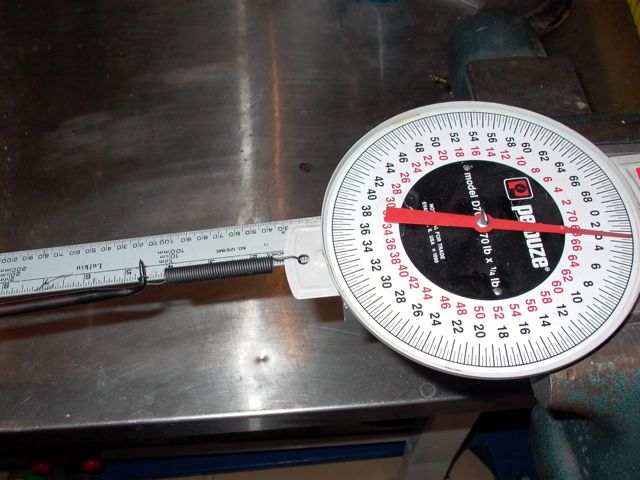
| ||
| Post# 732250 , Reply# 55 2/1/2014 at 14:08 (3,734 days old) by JWPATE () | ||
|
When refitting the pulley to motor shaft notice that the shaft is NOT flush with the pulley face. The service manual calls for a 1/32 inch recess. Here I just peered down the setscrew hole and lined up with the old tightening marks on the shaft flat. 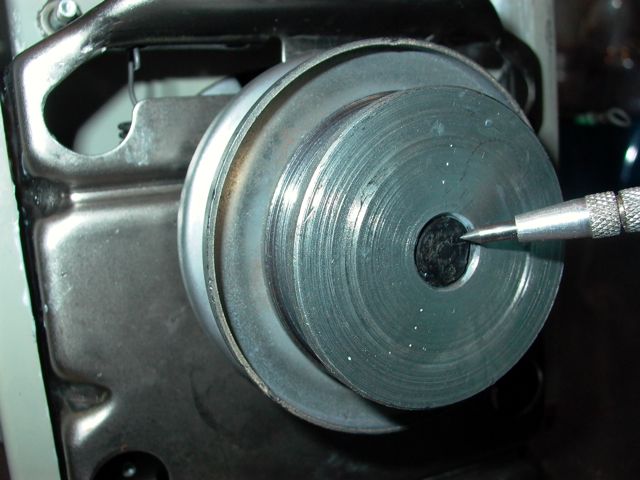
| ||
| Post# 732259 , Reply# 57 2/1/2014 at 14:16 (3,734 days old) by redcarpetdrew (Fairfield, CA) | ||

I would use the square 'rollers' on the carriage. The round ones will eventually break/fall apart just due to age. The new ones will work just fine if not a little better. Just trying to save you a possible headache later down the road...
Otherwise, just keep on going the way you are. You're doing awesome! RCD | ||
| Post# 732267 , Reply# 59 2/1/2014 at 14:24 (3,734 days old) by JWPATE () | ||
|
The wire ties form a sufficient curve to fit it in there well enough. But I do wonder if there is somewhere available some sort of double-ring plastic affair to make a better job of it. 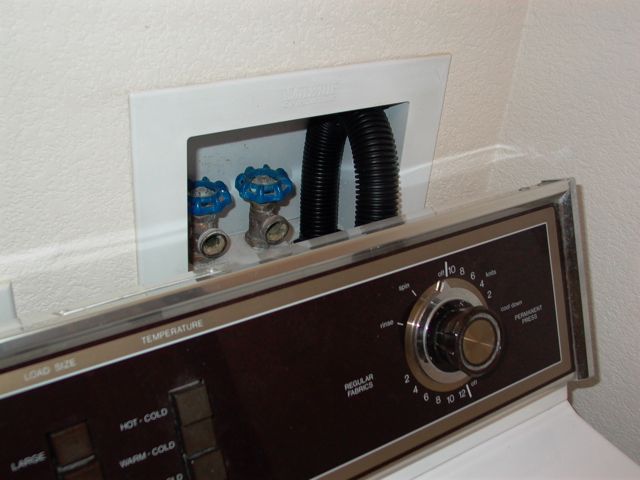
| ||
| Post# 732270 , Reply# 60 2/1/2014 at 14:48 (3,734 days old) by JWPATE () | ||
|
Thanks for the advice Drew. Get with it James - and don't ask for expert advice unless you are prepared to heed it. Now the square sliders are well lubed and in place. The old round sliders are in the trash, and all is back as it should be. Thanks again! | ||
| Post# 732357 , Reply# 61 2/1/2014 at 19:38 (3,734 days old) by norgeway (mocksville n c ) | ||
|
Its great to see! Someone do something RIGHT! You should be able to use it another 30 years! My Kenmore is 31 this year and I dread the thoughts of something happening to it, i certainly would never tackle what you did! | ||
| Post# 732420 , Reply# 63 2/2/2014 at 04:39 (3,734 days old) by redcarpetdrew (Fairfield, CA) | ||
 | ||
| Post# 732500 , Reply# 68 2/2/2014 at 15:47 (3,733 days old) by JWPATE () | ||
|
When one of these temp switches begins to give us trouble, I would first wonder about the contact points. So here I give them a few strokes with a flexible point cleaning strip. Just enough to clean them of any oxidation which may have formed there. 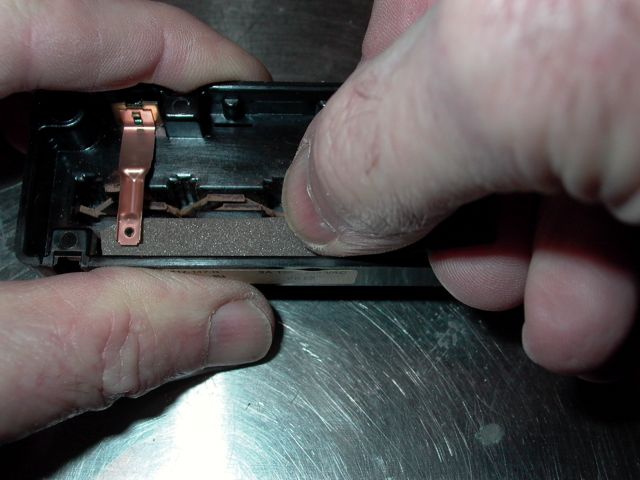
| ||
| Post# 732501 , Reply# 69 2/2/2014 at 15:52 (3,733 days old) by JWPATE () | ||
|
The three actuating shafts were each one corroded at the outside, or button end. Clean them up with fine steel wool and put a film of heavy grease. That Bosch grease is also helpful on the rounded ends which move the fiber sliders. 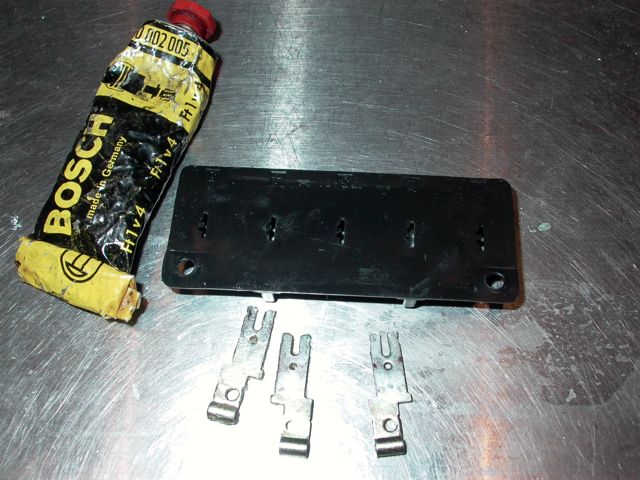
| ||
| Post# 732502 , Reply# 70 2/2/2014 at 15:55 (3,733 days old) by JWPATE () | ||
|
Button it back up and check that my tomfoolery hasn't ruined it. All seems well, the button action is smooth and continuity checks out with no resistance through the contact points. 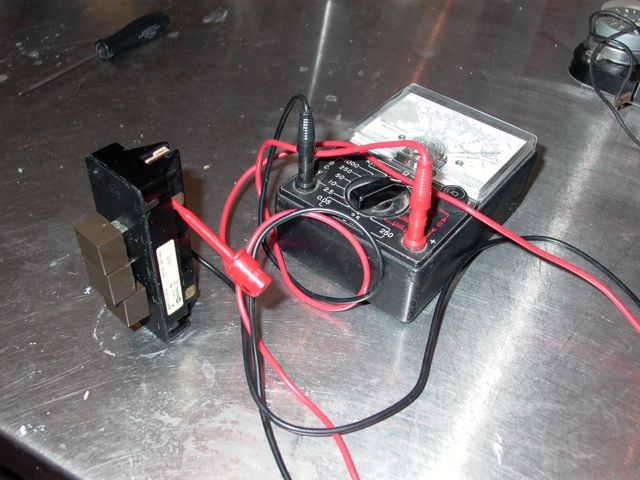
| ||
| Post# 732506 , Reply# 72 2/2/2014 at 16:08 (3,733 days old) by JWPATE () | ||
|
On to the timer switch. From the link Brian provided a few postings ago, it is understood that this unit is called the Late Mallory model, and much less complicated than earlier timers. Good! 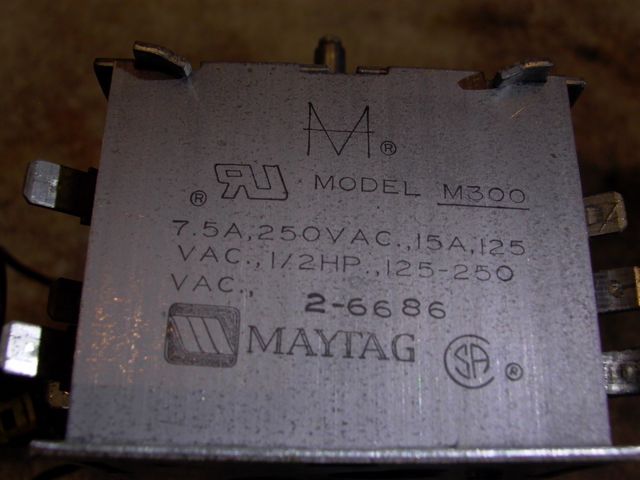
| ||
| Post# 732510 , Reply# 73 2/2/2014 at 16:15 (3,733 days old) by JWPATE () | ||
|
First we take out two fastening screws and remove the timer motor. 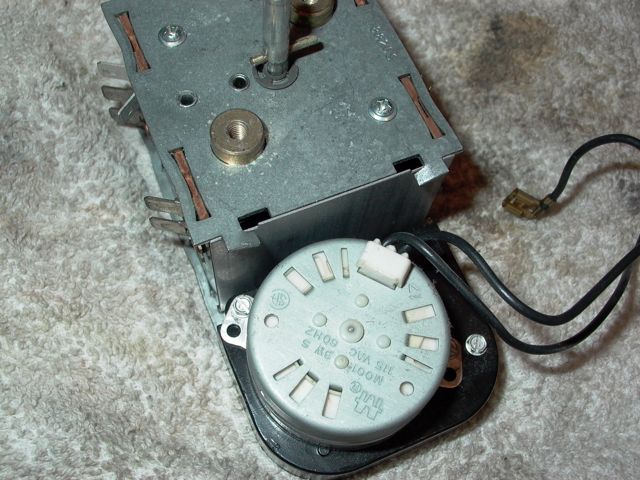
| ||
| Post# 732513 , Reply# 76 2/2/2014 at 16:31 (3,733 days old) by JWPATE () | ||
|
After it came out, I blew it out well and from every orifice I could find, using compressed air. And it really does seem clean as a whistle. 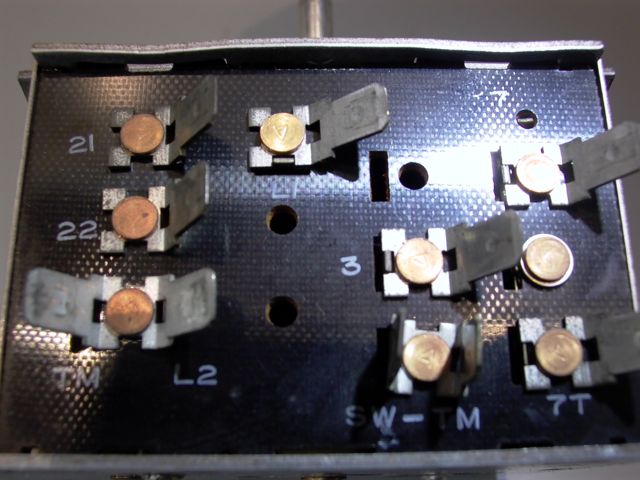
| ||
| Post# 732515 , Reply# 77 2/2/2014 at 16:35 (3,733 days old) by JWPATE () | ||
|
Will now allow the timer to air out and completely dry from the kerosene. Tomorrow I will lubricate it again with silicone spray generally, and grease for the gears. 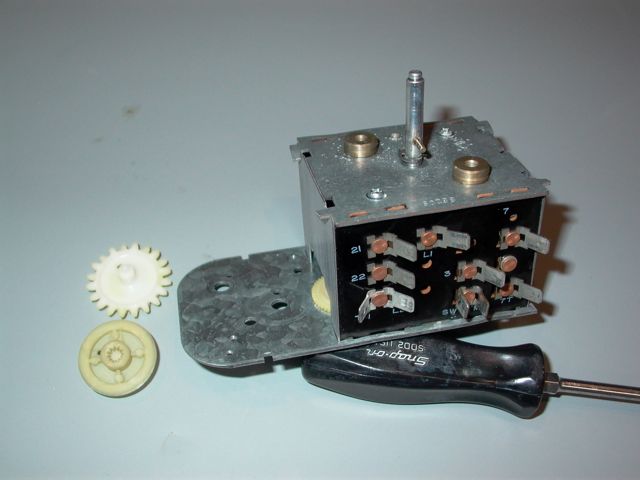
| ||
| Post# 732676 , Reply# 79 2/3/2014 at 13:07 (3,732 days old) by JWPATE () | ||
|
Grease lube was only used on the flat surface of the metal plate, upon which the gears reside. I also greased the axis shafts and the holes where they fit in. Silicone grease being used for this as I have confidence it will do no harm to the plastic parts. 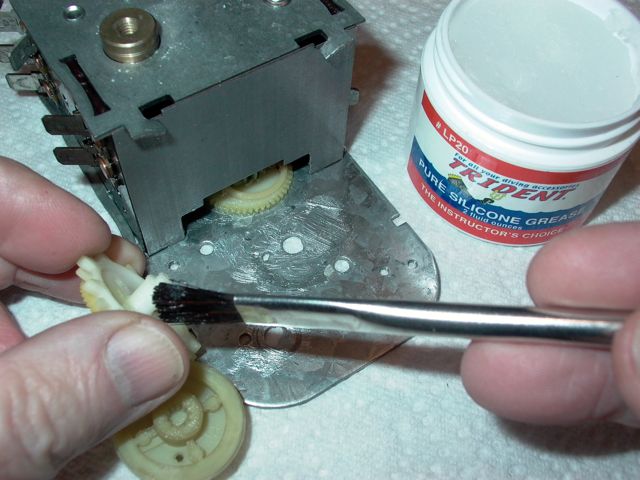
| ||
| Post# 732677 , Reply# 80 2/3/2014 at 13:10 (3,732 days old) by JWPATE () | ||
|
This looks like a dangerous toy does it not? And, certainly we must maintain our concentration when messing about with such a tool. 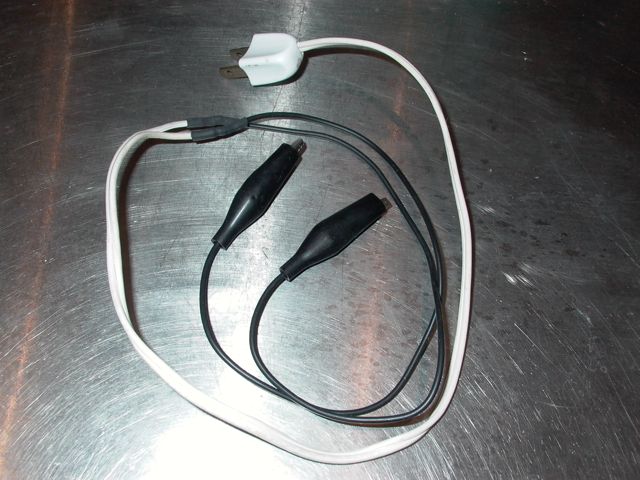
| ||
| Post# 732679 , Reply# 82 2/3/2014 at 13:23 (3,732 days old) by JWPATE () | ||
|
If we peer inside through one of the case holes it is possible to watch that second gear in the train make is periodic advances. At exactly one minute intervals it advances by six gear cogs, as seen through the case hole. 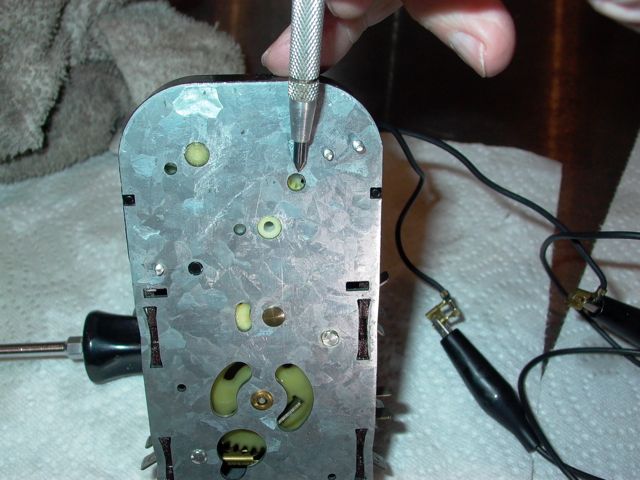
| ||
| Post# 732680 , Reply# 83 2/3/2014 at 13:26 (3,732 days old) by JWPATE () | ||
|
I suppose that is enough fun for now, with the control panel parts. Put the switches back where they belong, and hope they continue to perform as they have done these last 30 years. 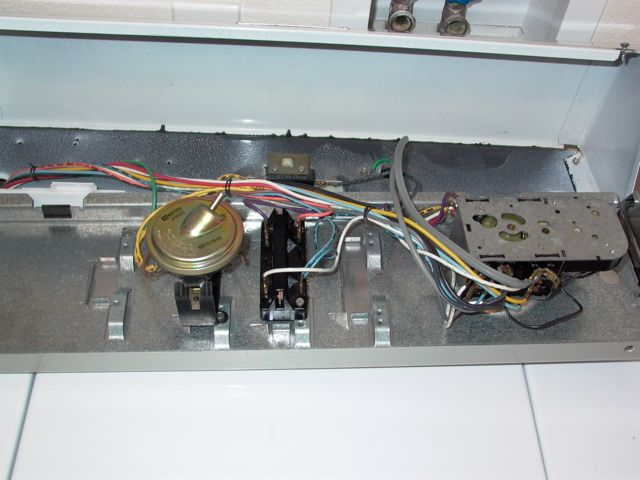
| ||
Post# 732686 , Reply# 84 2/3/2014 at 14:46 (3,732 days old) by Supersuds  (Knoxville, Tenn.) (Knoxville, Tenn.) |
||
Following this with great interest | ||
| Post# 732730 , Reply# 85 2/3/2014 at 19:27 (3,732 days old) by beekeyknee (Columbia, MO) | ||

Looking good James. That jar of silicone grease would probably be great for your motor carriage glides, if you haven't already put it back together (better than Molykote). And also your new damper pads when you glue them back on. Where did you get that jar of grease, if you don't mind?
That's funny you mentioning paying attention when using the extension cord and alligator clips. I've caught my mind wandering while using one of those and then suddenly snapping back to reality. B. | ||
| Post# 732753 , Reply# 86 2/3/2014 at 21:43 (3,732 days old) by JWPATE () | ||
|
Yes, that pure silicone grease isn't that easy to find, unless you have a scuba/dive shop nearby. I got that jar from amazon. | ||
| Post# 732852 , Reply# 91 2/4/2014 at 15:58 (3,731 days old) by DigAPony () | ||
|
Nice to see such remarkable attention to detail and done quickly as well. Good info, but going forward other high wear replacement parts will fail long before one of those original bearings. | ||
| Post# 733107 , Reply# 94 2/5/2014 at 15:37 (3,730 days old) by JWPATE () | ||
|
And it goes in place with ease. leave the hose clamps loose till the nozzle housing is fastened in place and then the clamps can be tightened with no strain on the hose sections. 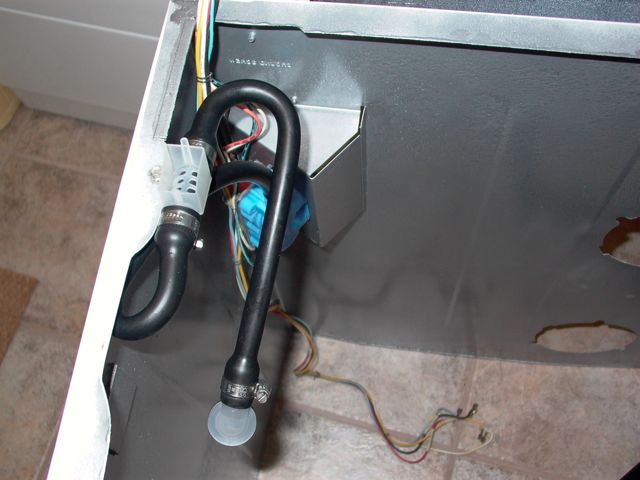
| ||
| Post# 733778 , Reply# 98 2/8/2014 at 15:52 (3,727 days old) by JWPATE () | ||
|
This sealing lip was the other problem area, and like the drain pipe it seems "good to go". 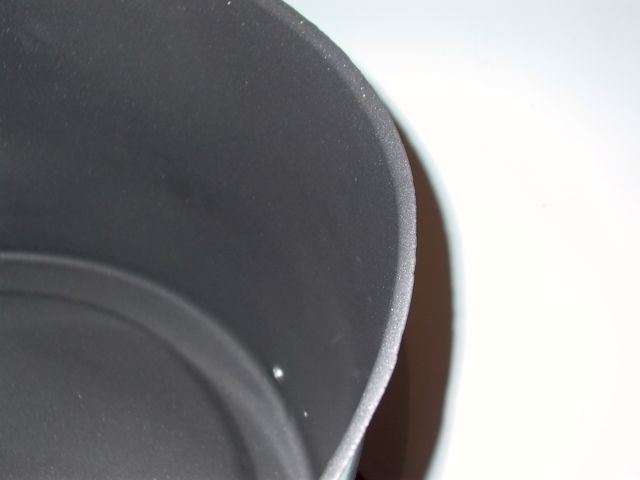
| ||
| Post# 733844 , Reply# 102 2/8/2014 at 20:43 (3,727 days old) by beekeyknee (Columbia, MO) | ||

Looks good to me so far, James. In the order of your posts, the dryer vent looks close to the ground. If possible, you might want to consider digging the ground out a bit underneath the vent to give the air more room to exhaust and also to be able to reach into the bottom of the vent to clean out lint deposits. It's hard to tell. It may just be the way the picture looks.
If looks are any indication, that tub looks like it should hold up well and the base looks nice as well. On a side note, the hole in the base is to help install the main drive belt. That isn't there on older models. The fill in the transmission looks right. After the machine has been run a few times you can check the tightness of the bolts again with a wrench. I've found after the transmission has been back together for awhile, the gasket compresses a bit and the bolts can be tighten a tad more. Out of curiosity, what did you put the transmission in while working on it? I've seen people use different things. One of my manuals says to drill a hole in your workbench for the purpose, but that's not always an option. | ||
| Post# 733930 , Reply# 105 2/9/2014 at 08:37 (3,727 days old) by JWPATE () | ||
|
Yes, that MAYTAG HEAVY DUTY TRANSMISSION LUBRICANT looks like, and pours like 90 wt gear oil. | ||
| Post# 734008 , Reply# 106 2/9/2014 at 15:42 (3,726 days old) by JWPATE () | ||
|
After powder coating, I especially wanted to clean the threads of that little 8/32 hole which provides a chassis ground for the motor circuits. While at it we may as well clean these four other threaded holes, then coat the threads with anti-seize. 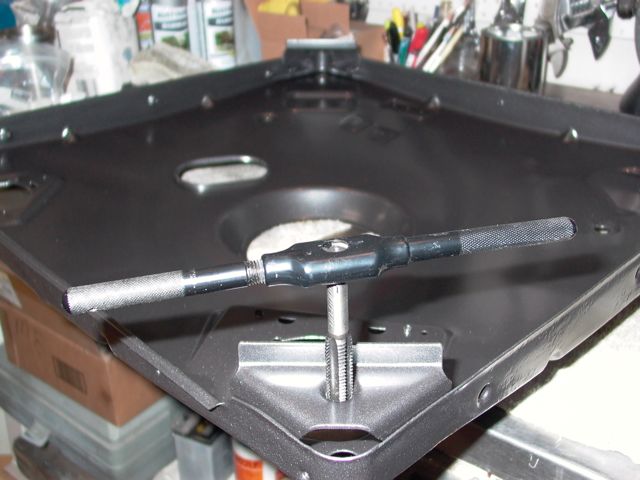
| ||
| Post# 734022 , Reply# 108 2/9/2014 at 16:01 (3,726 days old) by JWPATE () | ||
|
Now, lubricate the radial bearing surfaces and tap it down until it bottoms in that brake assembly recess. Then lubricate the brake assembly threads and also those splines which will engage the transmission lower case shaft. 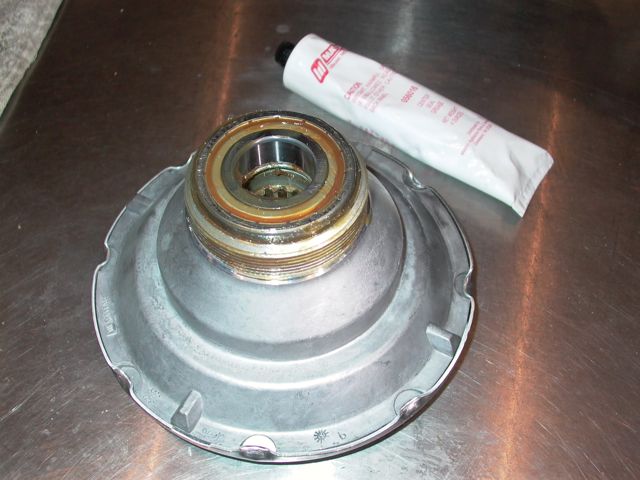
| ||
| Post# 734031 , Reply# 110 2/9/2014 at 16:13 (3,726 days old) by JWPATE () | ||
|
That's about all the weight I can handle before the base plate would become awkward for me. So I put it back where I found it. 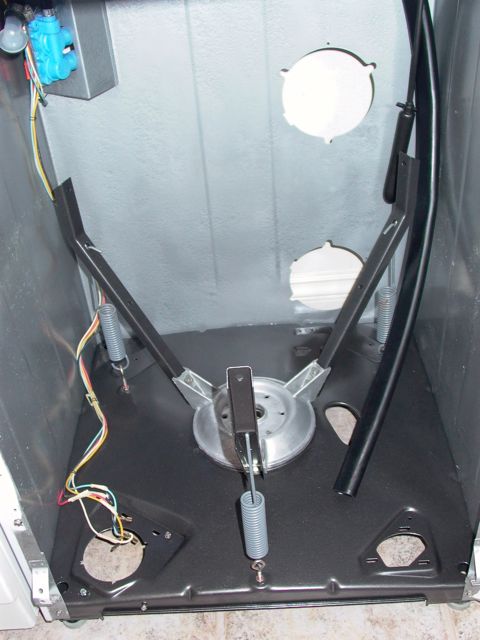
| ||
Post# 734049 , Reply# 111 2/9/2014 at 16:59 (3,726 days old) by akronman  (Akron/Cleveland Ohio) (Akron/Cleveland Ohio) |
||
Well,  | ||
| Post# 734261 , Reply# 113 2/10/2014 at 15:56 (3,725 days old) by JWPATE () | ||
|
Lightly lubricated the outer tub bearing with Dow Corning 111 and it slipped into place without issue. Then lubricated the bronze bushing with turbine oil. 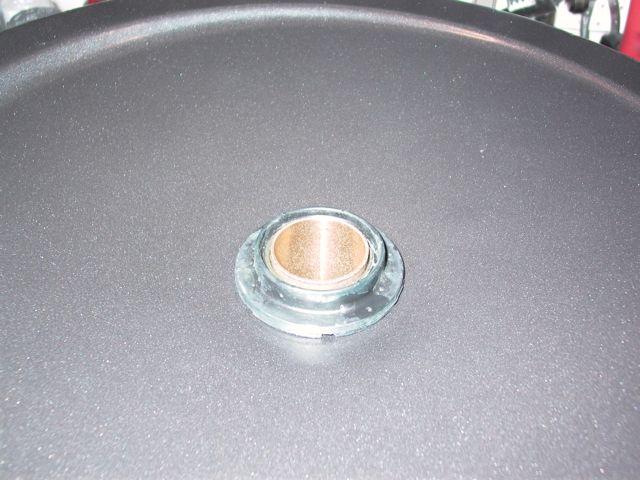
| ||
| Post# 734266 , Reply# 114 2/10/2014 at 16:03 (3,725 days old) by JWPATE () | ||
|
Here I am lubricating the transmission case with central seal grease, in hopes that it will inhibit the bearing sleeve from corroding to it the way aluminum and steel tend to do. Used the same grease to lubricate the inner surface of the steel bearing sleeve. 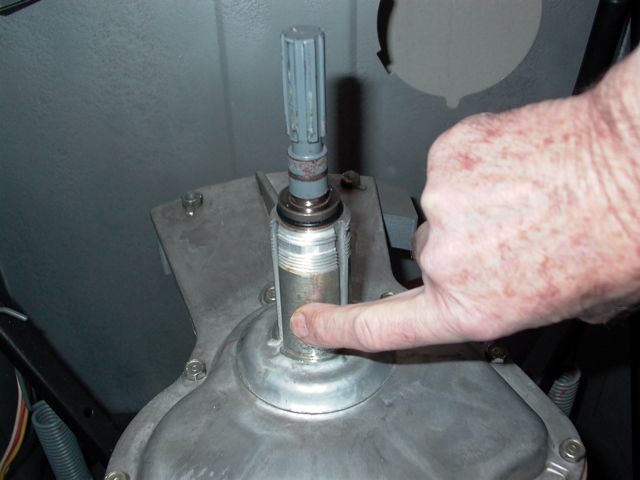
| ||
| Post# 734269 , Reply# 115 2/10/2014 at 16:06 (3,725 days old) by JWPATE () | ||
|
Slip the bearing sleeve in place on the transmission and then lubricate the outer sleeve surface with turbine oil. 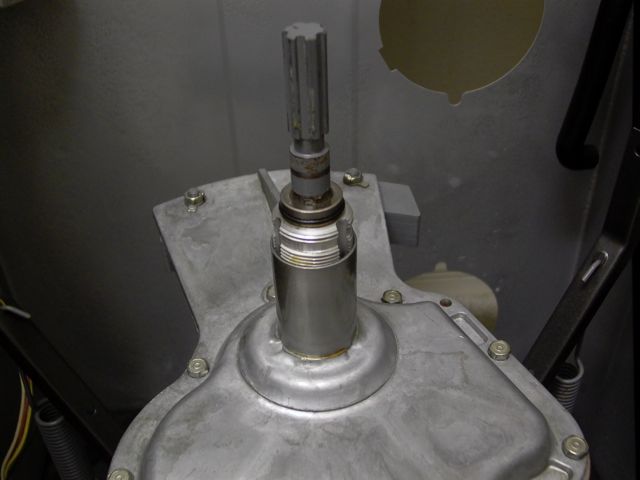
| ||
| Post# 734271 , Reply# 116 2/10/2014 at 16:11 (3,725 days old) by JWPATE () | ||
|
Bring the outer tub into action, pausing in this position long enough to attach the water level sensor hose. Then slip it down into place. 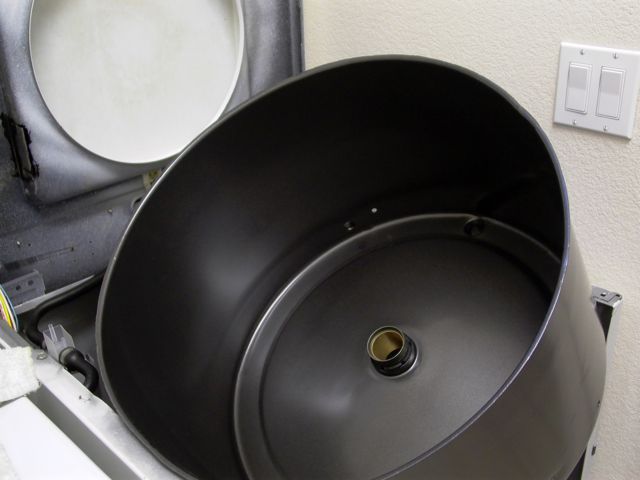
| ||
Post# 734332 , Reply# 123 2/10/2014 at 19:39 (3,725 days old) by mayfan69  (Brisbane Queensland Australia) (Brisbane Queensland Australia) |
||
Outstanding | ||
Post# 734446 , Reply# 124 2/11/2014 at 08:21 (3,725 days old) by akronman  (Akron/Cleveland Ohio) (Akron/Cleveland Ohio) |
||
Wow
This is one of the all-time professional rebuilds, and well documented. All I ever do is fix what's broke, seal up leaks, and de-rust and repaint. This, on the other hand, is as exact and complete as the engineers at the factory.
Keep up the good work and the pics and posts. Congratulations on your efforts and success! | ||
| Post# 734530 , Reply# 129 2/11/2014 at 16:42 (3,724 days old) by JWPATE () | ||
|
This post has been removed by the member who posted it. | ||
| Post# 734531 , Reply# 130 2/11/2014 at 16:48 (3,724 days old) by JWPATE () | ||
|
So now I can move on to these items. Lubricate the helix threads in the pulley, use a wheel bearing grease to pack the little brake rotor bearing, and tilt the machine back exposing the underside. 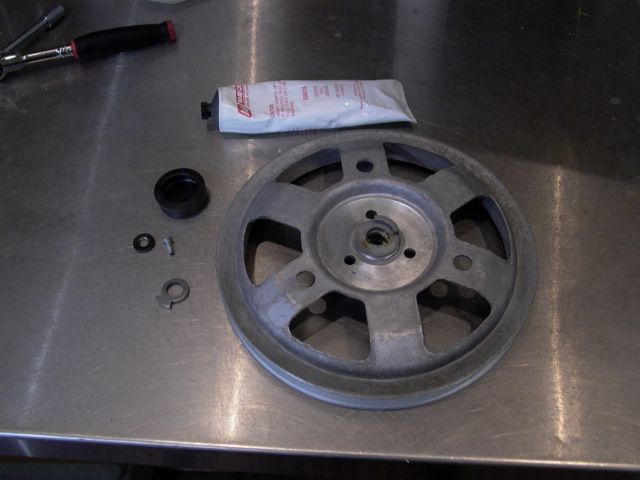
| ||
Post# 734579 , Reply# 135 2/11/2014 at 20:11 (3,724 days old) by jetcone  (Schenectady-Home of Calrods,Monitor Tops,Toroid Transformers) (Schenectady-Home of Calrods,Monitor Tops,Toroid Transformers) |
||
Wonderful thread | ||
| Post# 734631 , Reply# 136 2/11/2014 at 22:20 (3,724 days old) by beekeyknee (Columbia, MO) | ||

Hi James,
Congratulations. I could tell from early on that you were up to the task and one of those people that doesn't give up. It looks good. Fill us in a bit. Does the machine seem to run better and quieter than before? Any other details? I trust you took the screw plug out of the front of that pump and gave it a good dose of Zoom-Spout oil? B. | ||
Post# 734701 , Reply# 137 2/12/2014 at 09:06 (3,724 days old) by swestoyz  (Cedar Falls, IA) (Cedar Falls, IA) |
||
 James - I've been waiting with anticipation for your restoration to finish, and I'm glad everything went off without a hitch! I'll echo Jon's sentiments in that your accomplishments have resulted in quite a beautiful restoration.
I'll be really curious to hear how the power coating holds up after a year or so of washing. This could be a nice alternative for preserving outer tubs and such.
Again, way to go!
Ben This post was last edited 02/12/2014 at 13:45 | ||
| Post# 735345 , Reply# 139 2/15/2014 at 00:48 (3,721 days old) by redcarpetdrew (Fairfield, CA) | ||
BRAVO! | ||
| Post# 735461 , Reply# 140 2/15/2014 at 14:54 (3,720 days old) by kitty () | ||
|
Just wondering about the spin clutch... What type of clutch is it? Multiple spin drains would really wear out a regular one. | ||
| Post# 735562 , Reply# 141 2/15/2014 at 22:58 (3,720 days old) by redcarpetdrew (Fairfield, CA) | ||
The Dependable Care spin clutch.
There really isn't a spin clutch as you would imagine it. On the two belt system, the pump belt is designed to get up to speed right away to start the pump out process. On the other hand, the drive belt from the motor to the trans pulley is designed to 'slip' at the motor pulley. So, when the Maytag goes into spin, the pump starts draining the water out right away while the tub starts to spin slowly, gaining speed, giving time for the load to empty providing less stress on the mechanism or 'clutching'...
The belts are designed to slip without premature wear out. One problem I see frequently is when the homeowner tries to replace the Maytag designed belts with plain automotive belts, which are NOT designed to slip. The drive belt tries to spin the full tub up to speed right away, causing belt damage or cause the motor to kick out on overload or possibly even be damaged from the stress. Plain as mud, right? RCD | ||
Post# 735619 , Reply# 143 2/16/2014 at 10:16 (3,720 days old) by combo52  (50 Year Repair Tech Beltsville,Md) (50 Year Repair Tech Beltsville,Md) |
||
MT 2 Belt Spin Clutch In The Transmission ?
The two disk washers under the pinion gear do not slip as the washers tub is coming up to speed while draining. The steel and copper washers are thrust washers that engage quickly and very completely as soon as the pinon gear pulls and the main drive pulley starts turning clockwise. If you have two people one can hold the transmission stationary while the other tries to turn the main drive pulley, it does not slip.
John L. | ||
| Post# 735698 , Reply# 146 2/16/2014 at 19:10 (3,719 days old) by kitty () | ||
|
Something I forgot to add... That rebuild/restoration is AMAZING! I don't think I could have done that. Your metal work is INCREDIBLE! Keep up the good work! | ||
Post# 1040599 , Reply# 147 8/4/2019 at 01:17 (1,725 days old) by hobbyapocalypse  (Northeast Pennsylvania) (Northeast Pennsylvania) |
||
|
Hose clamp Reply #23 | ||
Post# 1040655 , Reply# 148 8/4/2019 at 12:08 (1,725 days old) by LowEfficiency  (Iowa) (Iowa) |
||
 >> Trying to figure out what is different about the clamp shown on the right. The difference is in how the tail end of the hose clamp is manufactured. The clamp type on the left is more common, and has slots stamped all the way through the metal - they are holes that you can see through. The worm gear teeth engage these slots. The clamp type on the right is different in that the stamping doesn't go all the way through - instead, it forms the metal into ridges. There are no holes, and you can't see through it. The worm gear teeth engage these ridges when you tighten the clamp. The issue: With the clamp type on the left, what happens is that over time, especially if over-tightened, the rubber hose will begin to squish out through those holes. When you remove the clamp, it will leave a distinct impression of where the clamp had been, and sometimes the rubber will have been damaged. There are also times where the worm gear teeth will slice slightly into the top of the rubber hose through the band. The style on the right aren't always perfectly smooth (some are better than others), but theoretically, they would lessen this distortion of the hose and eliminate the small cuts. There are lots of other ways around this issue - some worm clamps have an extra strip of smooth metal around the inside which guards the hose from those slots. Then there are T-Bolt hose clamps, the nut-and-bolt strap style, spring clamps, etc. Maytag used some nice hose clamps from the factory (not sure what that style is called off-hand), but later parts kits all substitute the cheaper worm drive clamps. (re-attaching the original image for reference)
View Full Size
| ||

 Comes to the Rescue!
Comes to the Rescue!